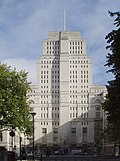University of London
Expression error: Unexpected < operator.Expression error: Unexpected < operator.
| Latin: [Universitas Londiniensis] Error: {{Lang}}: text has italic markup (help) | ||||||||||||
| Type | Public | |||||||||||
|---|---|---|---|---|---|---|---|---|---|---|---|---|
| Established | 1836 | |||||||||||
| Chancellor | HRH The Princess Royal | |||||||||||
| Vice-Chancellor | Professor Geoffrey Crossick | |||||||||||
| Visitor | The Rt Hon Nick Clegg As Lord President of the Council | |||||||||||
| Students | 135,090 internal (2005-2006)[1] 50,000 International Programmes[2] | |||||||||||
| Location | , | |||||||||||
| Colours | ||||||||||||
| Website | london.ac.uk | |||||||||||
The University of London is a university in London, England. It is a federal university made up of 31 affiliates. There are nineteen university institutions and twelve research institutes.[3]
The headquarters of the university, Senate House, is in Malet Street in the Bloomsbury area of Camden. This is near University College London and the British Museum.
The University of London is the largest university in the UK by number of full-time students, with 135,090 campus-based students and over 45,000 in the University of London International Programmes.
The constituent colleges are responsible for the teaching, the research or the individual students and staff of the constituent colleges; the university is not. The university is an administrative body responsible for standards, degree examinations and certification.
The university was first established by a Royal Charter in 1836, which brought together in federation London University (now University College London) and King's College (now King's College London).
Graduates of the University of London may use the post-nominal letters 'Lond.' or 'Londin.' (both from Londiniensis) after their degree abbreviations.
The university's biggest colleges are Birkbeck, Goldsmiths, King's College London, the London Business School, Queen Mary, Royal Holloway, SOAS, LSE and UCL.[4]
History

Founded in 1836, the University at first comprised just two colleges. They were University College London (founded in 1826), which did not apply religious tests to its students, and King's College (founded in 1829), which admitted only members of the Church of England. Therefore, both University College and King's pre-date the University of London, which initially served solely as an examining body for the constituent colleges.
In 1858 the University expanded its role by offering the University of London International Programmes to candidates outside the colleges, the first of its kind in the country. A new headquarters at 6 Burlington Gardens, providing the university with exam halls and offices, was built to accommodate the new role.
In 1878 the University became the first university in the UK to admit women on equal terms with men. Four female students obtained Bachelor of Arts degrees in 1880 and two obtained Bachelor of Science degrees in 1881, again the first in the country.[5]
University Of London Media
General Examination for Women certificate from 1878. These were issued 1869–1878, before women were admitted to degrees of the university.
The Imperial Institute building in South Kensington, home to the university from 1900 to 1937
Senate House, constructed 1932–1937: the headquarters of the University of London
References
- ↑ Combined total of "Table 0a - All students by institution, mode of study, level of study, gender and domicile 2005/06". Higher Education Statistics Agency online statistics. Retrieved 2007-07-15. Imperial College London has left the University since the year 2005-2006.
- ↑ "About us". University of London International Programmes website. Retrieved 2007-07-15.
- ↑ "University of London: Colleges/Institutes". London.ac.uk. 2010-03-29. Archived from the original on 2017-11-25. Retrieved 2010-04-13.
- ↑ "Where do HE students study? | HESA".
- ↑ "University of London: Brief history". London.ac.uk. Archived from the original on 2014-02-09. Retrieved 2010-04-13.








